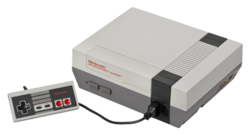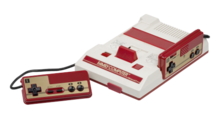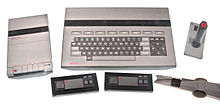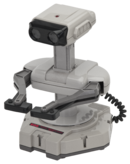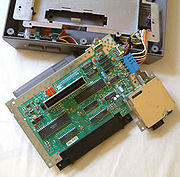Nintendo Entertainment System
| Nintendo Entertainment System | ||||
|---|---|---|---|---|
| Manufacturer | Nintendo | |||
| Type | stationary game console | |||
| generation | 3rd generation of consoles | |||
| publication |
|
|||
| Main processor | Ricoh 2A03 | |||
| Graphics processor | PPU Ricoh chip | |||
| Storage media | Modules | |||
| Controller | NES controller (wired gamepads with a D-pad , two action buttons and start and select buttons) | |||
| Online service | Family Computer Network System (Japan only) | |||
| Units sold | approximately 61.91 million
(As of September 30, 2019) |
|||
| Most successful game |
|
|||
| predecessor | Color TV-Game 15 | |||
| successor | Super Nintendo Entertainment System | |||
| info | Nintendo's first game console released worldwide | |||
The Nintendo Entertainment System (usually called NES for short ) is a stationary 8-bit game console from the Japanese game console manufacturer Nintendo . The console appeared in North America , Brazil , Europe , Asia, and Australia . The Japanese version was marketed as Famicom (short for Family Computer ). The NES has long been the best-selling console of all, with over 60 million units sold. After the collapse of the video game industry in 1983 , the so-called " Video Game Crash ", Nintendo revitalized the home console market with its console. The controller led the directional pad (short: D-Pad for Direction pad ) and defined the fundamental key arrangement of the gamepad . Well-known game series such as Super Mario Bros. , The Legend of Zelda , Metroid and Castlevania made their home console debut at the NES.
history
After a few successful arcade machines in the early 1980s, Nintendo planned a video game console for home use with interchangeable game modules. Masayuki Uemura finally designed the Famicom, which was released in Japan on July 15, 1983 and priced at 14,800 yen. By the end of 1984, the Famicom had become the best-selling video game console in Japan. At that time, Nintendo was already planning to launch sales in the US, where the video game market was virtually non-existent due to the industry collapse in 1983. At first there was the consideration of releasing the console in the USA under Atari's name, but their interest focused more on the home computer market. That's why Nintendo took distribution into its own hands.
For the first time the console was presented as a Nintendo Advanced Video System , with accessories such as a keyboard, cassette recorder, infrared joystick and a special BASIC Programming Language module. The complicated and cluttered AVS was revised again and presented in a slimmed-down version at the CES ( Consumer Electronics Show ) in June 1985 as the Nintendo Entertainment System . After a successful start in New York with around 50,000 units sold, the NES was finally published nationwide on October 18, 1985; Initially only in selected sales outlets, later the console could be bought everywhere. The console was offered in two different packages: The NES Deluxe Set included the ROB (see below), a zapper (see below), two controllers and the games Duck Hunt and Gyromite and was available for 249 US dollars ; the NES action set with a Super Mario Bro / Duck Hunt multi module was available for USD 199. For the remainder of the decade, the NES was the undisputed No. 1 in the American and Japanese markets, and the games broke one sales record after another.
In Europe and Australia - the regions with PAL television standard - the markets were divided into PAL A and PAL B. Mattel (PAL A) was responsible for the distribution of the NES and its games in Great Britain , Australia and Italy ; the PAL-B market, which consisted of the rest of Europe, was divided among various distributors (for example the company Bienengräber in Germany, which had already successfully sold the Game & Watch games). With the opening of Nintendo of Europe, Nintendo took over the distribution itself.
When the first 16-bit consoles (such as the Sega Mega Drive ) arrived in the 1990s , the dominance of the NES was slowly coming to an end. Nintendo also released the successor console Super Nintendo Entertainment System , or SNES for short , at the beginning of the 1990s . Nintendo continued to support the NES and released a new, smaller version of the console in the US, Japan and Australia. In 1995, Nintendo of America officially took the NES out of the program after constantly falling sales. The last games appeared in Europe in 1996. In Japan, production of the AV Famicom continued until 2003.
After the official end of the console in the West, a lively community of collectors developed around the 8-bit device. Along with the growing emulation scene, the console experienced its second spring, so to speak, in the late 1990s. Even today, the NES and its games are not only popular with video game collectors. It is not uncommon for coveted modules and accessories to be paid much more than they cost when they were first released.
Games
The most successful game on the NES is Super Mario Bros., which was sold in the West along with the console. With over 40 million units sold, it was by far the best-selling video game ever, until it was surpassed by Wii Sports, which sold 82.69 million units in 2008 .
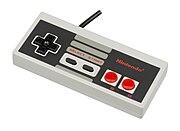
Some more popular games on the NES:
Accessories for the NES
Famicom Disk System
In Japan, a floppy disk drive appeared for the Famicom, which is connected to the console via the module bay. Numerous well-known games were implemented on diskette or even made their debut there.
Power pad
The Power Pad mainly supports sports games. The various buttons on the mat are operated with the feet, which means that the character on the TV starts running or jumping. In Europe, there were only two games that made use of the fitness mat, Athletic World and Stadium Events , while in the USA the selection was slightly larger. As a concept, it is a direct predecessor of the Wii balance board that was successfully marketed for the Wii (Wii Fit).
NES Advantage
The NES Advantage is a Joyboard modeled after an arcade machine, including buttons and joystick . The input device should be ideally suited for classic arcade games such as shoot 'em ups . In addition to the joystick, the device also offers adjustable auto-fire buttons and a slow-motion function, which, however, only represents a repeated call of the start button, which activates the pause function in most arcade ports for the NES, as if one were repeatedly pause the game for a short time so that the game progresses more slowly. The NES Advantage has two connection cables to allow two players to take turns playing with it. On the top is the slide switch for changing the active player.
In the US science fiction - Comedy Ghostbusters II is a NES Advantage as a prop to control the Statue of Liberty used.
NES Four Score
The NES Four Score is a multiplayer adapter and allows up to four players to play with or against each other at the same time. Games that support the Four Score are for example Nintendo World Cup , Gauntlet 2 or Super Spike's V'Ball. In addition to the four controller connections, there is also a manual auto fire function for the A and B buttons.
NES Max
The official NES Max controller, like many later controllers, offers a handle on the left and right to make holding the control more comfortable. The most noticeable feature of the input device, however, is the so-called cycloid, a disc that replaces the standard control pad and can be pushed around and indicates the direction when pressed. In addition, car fire buttons from A and B were attached.
Power Glove
The Power Glove is a data glove for the right arm. Using sensors to be attached to the TV, you can control the game by moving your arm. A control was already programmed for numerous titles, but for many you still have to calibrate them yourself. The game Super Gloveball was specially designed for the Power Glove, otherwise the practical use was very limited. In the computer game culture he achieved dubious fame, which can be traced back to one of the earliest examples of a "hype backlash": Nintendo had the Powerglove (among many other all too obvious product placements ) in the Hollywood blockbuster Joy Stick Heroes (English The Wizard ) apply before the actual sales launch. The dissonance between advertising promises and reality and the involuntary comedy of the film dialogue, which reflects this a posteriori (quote: "I love the Powerglove. It's so bad !" ; Whereby bad can be understood as "totally blatant" or "terribly bad" at the same time), has secured the device a firm place in the humor of nerd culture for the time being.
In the short film Kung Fury , the plot of which is set in 1985 , the hacker "Hackerman" uses the Power Glove to travel through time .
ROB
The Robotic Operation Buddy, ROB for short, which was originally to be called OTTO, was part of the basic equipment of the Deluxe Set in the USA . Four AA batteries and a D battery for the gyro motor are required for operation. Using sensors in the eyes, the little robot can receive information and commands from the TV screen, which are triggered by pressing a button. For example, ROB lifts blocks and simultaneously opens a locked door during the game. It was introduced at the 1985 Summer Consumer Electronics Show in Chicago and made sales of the NES soar in the United States. In total, only two games made use of the bizarre accessories: Gyromite (included with the deluxe set) and Stack Up. Although ROB worked very slowly and was comparatively bulky to use, it is now considered a rare collector's item among retro gamers and has achieved a certain cult status. He can be played as a character in Mario Kart DS , Super Smash Bros. Brawl , Super Smash Bros. for Nintendo 3DS / for Wii U and Super Smash Bros. Ultimate .
Zapper
The zapper is a light gun for the NES, which was already delivered with the start (depending on the set). The light pistol, available in gray or orange, is aimed at the TV screen and, for example, shot at clay pigeons. The most popular games for this input device are Duck Hunt , Gumshoe and Wild Gunman ; other titles include Barker Bill's Trick Shooting, Shooting Range and Operation Wolf . In principle, this type of lightguns only works with classic tube televisions. For Nintendo's newer home console Wii there is a newer version of the zapper.
Family Computer Network System
In Japan, the Family Computer Network System appeared, a modem that made it possible to use various online services at the NES. A server provided services such as weather reports, share prices or cheats for users. Games that could be played over the Internet were planned but never realized.
Other accessories
In Japan in particular there were a number of other hardware accessories, some of which were bizarre. This includes a microphone for karaoke games, a modem plus an accompanying keyboard, record player, cassette drive, 3D glasses called the Famicom 3D System and even a knitting machine. In addition, various controller variants and import adapters appeared all over the world, which enable games from other regions to be played on your own console. There were also cheating modules such as Action Replay or Game Genie , which, for example, can create unlimited lives in the game by entering codes.
Technical specifications
- CPU : Ricoh 2A03 (a 6502 derivative) clocked at 1.77 MHz (PAL) / 1.79 MHz (NTSC)
- Graphics chip: PPU Ricoh chip (NTSC: RP2C02, PAL: RP2C07) clocked at 5.37 MHz or 5.32 MHz
- Sound chip: The sound functions are integrated in the CPU (5 sound channels). Two square waveforms with variable pulse width, a triangle waveform, a noise generator and a 6-bit digital delta PCM sound channel.
- Storage:
- RAM : 2 KB (some games such as Super Mario Bros. 3 (8 KB) contain additional RAM)
- Video RAM: 2 kB
- Module size: 192 Kbit - 6 Mbit
- Resolution :
- Colors and sprites:
- Dimensions: 255 mm × 85 mm × 202 mm
- Weight: 1247.9 g
Redesign of the NES
A more compact, newer version of the NES appeared in North America and Australia towards the end of the 8-bit era. In North America, the console was released in 1993 at a price of $ 49.99. Nintendo itself continued to sell the device as a Nintendo Entertainment System, with top loading NES and NES 2 becoming established as popular names among buyers .
Changes from the standard NES
- The hardware is almost identical, but the composite outputs are missing.
- New slot for the modules, so-called top loader, because the module no longer has to be pushed in horizontally and then pushed down, but is inserted vertically from above.
- The exterior has been completely redesigned and is very similar to the American version of the SNES
- The gamepad of the redesigned NES is also very similar to that of the SNES and is known as a DogBone controller due to its design.
- The toploader can be used universally, i. that is, it can play US games as well as European games.
- One point of criticism of the device are vertical stripes that can be seen on the screen while gaming. In response, Nintendo released an improved version of the console (known as the Famicom "AV" in Japan).
Nintendo Classic Mini: Nintendo Entertainment System
On July 14, 2016, Nintendo announced the Nintendo Classic Mini: Nintendo Entertainment System, a new, smaller version of the NES, which comes with 30 pre-installed games and was released on November 11, 2016. All games are pre-installed, the device does not have a data interface for expansion.
The following 30 tracks are stored on the device:
NES-compatible replicas ("Famiclones")
The NES is one of the most unlicensed game consoles of all time. As a collective term for these consoles, the word "Famiclone" has become established, which is derived from "Famicom" (the Japanese NES version) and "Clone" (replica, clone ). Even in 2010, 25 years after the console was released in the USA and despite the fact that much more powerful 3D game consoles are available in their fourth generation, NES-compatible game consoles are still being manufactured. Since some NES patents in the USA already expired in 2005, so-called "Famiclones" can now be legally sold there, provided that they do not contain any copyrighted games, as their copyright protection is still in place. The consoles officially sold as NES-compatible include "Generation NEX", "Yobo FC" and "Famicom Portable". However, these so-called Famiclones are not readily compatible with US and Pal-NES games, since the Japanese Famicom games have fewer connection pins and thus shorter PCBs. Famiclones are also almost never compatible with official accessories, as other connections are used for the controllers (mostly 9-pin DSub sockets).
Nintendo Entertainment System - Nintendo Switch Online
As part of the paid online access Nintendo Switch Online for the Nintendo Switch on September 19, 2018, Nintendo released the virtual Nintendo Entertainment System. Online service customers can choose from a library of NES games on the Nintendo Switch that is growing every month. In line with this, Nintendo has released controllers in the NES design that can be wirelessly connected to the Switch console.
See also
- PlayChoice-10 ( NES-based arcade machine )
- NES sound format
- NES Remix , game mix for Wii U and Nintendo DS
literature
- Rainer Babiel, Ulrich Krockenberger: NES Game Power . Sybex, Cologne 1991, ISBN 3-88745-899-0 .
- Pat Contri: Ultimate Nintendo: Guide to the NES Library (1985-1995). The Punk Effect, USA 2016, ISBN 978-0997328301 .
- Nick von Esmarch, Garitt Rocha: Playing With Power: Nintendo NES Classics. Prima Games, USA 2016, ISBN 978-0744017670 .
- Timothy L. Hearn: The Nintendo Entertainment System: A Comprehensive Look at the History, Technology, and Success of the NES. CreateSpace Independent Publishing Platform, USA 2015, ISBN 978-1517779214 .
- Jeremy Parish: Good Nintentions: A 30th Anniversary of Nintendo Entertainment System. CreateSpace Independent Publishing Platform, USA 2015, ISBN 978-1512109740 .
- Jeremy Parish: Good Nintentions 1985: The Definitive Unauthorized Guide to Nintendo's NES Launch. CreateSpace Independent Publishing Platform, USA 2016, ISBN 978-1537080796 .
Web links
- Technical data of the NES . In: Nintendo.de
- NES Center: Largest German NES website. Offers test reports, tips & tricks, reports, etc. (German)
- Bob Rust: NES game development (English)
- Technical documentation about how the NES Architecture (English)
- Official German-language website of the Four Score
Individual evidence
- ↑ Hardware and Software Sales Units. Nintendo, accessed August 14, 2015 .
- ↑ Nerdism Reviews! April 26, 2012, accessed February 23, 2020 .
- ↑ LaserUnicorns: KUNG FURY Official Movie [HD]. May 28, 2015, accessed June 27, 2016 .
- ↑ a b c d e f R.OB - How a little robot saved the NES. September 21, 2019, accessed July 4, 2020 .
- ↑ GlitterBerri's Game Translations: Developing the Famicom Modem. June 29, 2012, accessed April 9, 2017 .
- ↑ Rgame - NES specificaties. Retrieved July 20, 2012 (English).
- ↑ Nintendo.de: Nintendo Classic Mini: Nintendo Entertainment System , accessed on July 22, 2016

